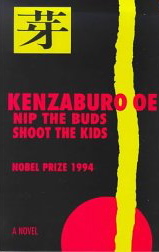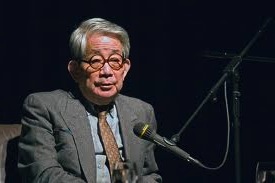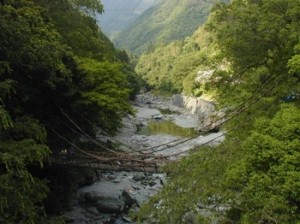Note: Kenzaburo Oe was WINNER of the Nobel Prize for Literature in 1994.
“Listen, someone like you should be throttled while they’re still a kid. We squash vermin while it’s small. We’re peasants: we nip the bad buds early.”
Written in 1958, when the author was only twenty-three, this debut novel is stunning for its depiction of two societies–the society of peasant villagers who live in a remote and nearly inaccessible mountain village, and a society created by young delinquents when they are abandoned and blockaded inside this small village. It is also reflects the author’s vision of the broader society of Japan in the aftermath of World War II. Author Kenzaburo Oe himself grew up in a remote and nearly inaccessible village in Ehime Prefecture on the island of Shikoku. He was ten years old when the war ended and the Emperor, the “living god,” announced the surrender of the country. In the years leading up to the publication of this novel, Japan and the Occupation forces came to agreements and influenced each other, and Oe believes that this led to a sense of emptiness and ambiguity in society–the old values and ways of life were gone, while the increasingly influential western values were not necessarily compatible with Japanese history.
1958, when the author was only twenty-three, this debut novel is stunning for its depiction of two societies–the society of peasant villagers who live in a remote and nearly inaccessible mountain village, and a society created by young delinquents when they are abandoned and blockaded inside this small village. It is also reflects the author’s vision of the broader society of Japan in the aftermath of World War II. Author Kenzaburo Oe himself grew up in a remote and nearly inaccessible village in Ehime Prefecture on the island of Shikoku. He was ten years old when the war ended and the Emperor, the “living god,” announced the surrender of the country. In the years leading up to the publication of this novel, Japan and the Occupation forces came to agreements and influenced each other, and Oe believes that this led to a sense of emptiness and ambiguity in society–the old values and ways of life were gone, while the increasingly influential western values were not necessarily compatible with Japanese history.
Many western readers of this novel will be shocked to discover how “un-Japanese” in style this novel is. Oe, a student of Sartre and Heidegger in college, embraces those influences in his writing, instead of the delicacy, subtlety, and minimalist simplicity one usually associates with the Japanese arts. The novel is characterized by dense imagery, a strong narrative l ine and powerful emotions, violence presented as an understandable response to injustice, and an indictment of the communal mindset which can lead to expedient decision-making at the expense of the individual and his liberty. The Lord of the Flies atmosphere which evolves here is a strong statement of Oe’s feelings about his society–one he feels lacks a clear appreciation of the value of the individual.
ine and powerful emotions, violence presented as an understandable response to injustice, and an indictment of the communal mindset which can lead to expedient decision-making at the expense of the individual and his liberty. The Lord of the Flies atmosphere which evolves here is a strong statement of Oe’s feelings about his society–one he feels lacks a clear appreciation of the value of the individual.
Narrated by an unnamed delinquent who is one of fifteen boys being evacuated from their reformatory to a remote mountain during the war, the novel shows the inhumanity with which these boys are treated by the peasants for whom they are expected to work clearing the fields. The boys, malnourished and exhausted, arrive in time to bury a huge pile of animal carcasses, and they soon discover that these animals have died from a plague–the villagers themselves did not want to touch them. When one of the boys dies, followed soon after by a woman in the village, the villagers take off to avoid infection, barricading the way out so that the boys cannot escape. They must then set up their own society if they are to survive. Since the peasants had treated them cruelly, they find that being on their own is a dream come true. For the first time, some of them no longer feel like outsiders.
 Away from normal society, the boys are free to express their own emotions, and the narrator and others quickly show their inner humanity. The narrator’s much younger brother, an innocent, depends upon the narrator, who is protective and warm towards him, with several people protecting also the young daughter of the woman who died from plague, a girl who was abandoned when the villagers evacuated and left all the “undesirables” behind. As the boys help each other, the author creates a real sense of pathos about their sad predicaments. Passages of great beauty–especially the morning in which they discover snow–contrast with the misery of their attempts at survival. Then everything changes.
Away from normal society, the boys are free to express their own emotions, and the narrator and others quickly show their inner humanity. The narrator’s much younger brother, an innocent, depends upon the narrator, who is protective and warm towards him, with several people protecting also the young daughter of the woman who died from plague, a girl who was abandoned when the villagers evacuated and left all the “undesirables” behind. As the boys help each other, the author creates a real sense of pathos about their sad predicaments. Passages of great beauty–especially the morning in which they discover snow–contrast with the misery of their attempts at survival. Then everything changes.
Oe’s novel is an intense and passionate story about the mindless behavior of the majority against “outsiders.” His use of delinquents, by no means perfect or innocent, as the “heroes” of the novel sets the actions of the villagers into sharp relief. The ending is a further indictment of the use of power to control outcomes. Anyone who has enjoyed Lord of the Flies owes it to him-/herself to read this novel, which is as powerful today as it was when it was written. It is far more complex in its characterizations and themes and far less artificial and allegorical than Lord of the Flies. The latter, written in 1954, sold only a few copies upon publication and was not reprinted until the early 1960s, at which point it became enormously popular. This 1958 novel appears to have sprung independently from completely different inspirations. It is ironic that both William Golding and Kenzaburo Oe have won Nobel Prizes for Literature for their literary efforts, Golding in 1983 and Oe in 1994.
Notes: The author’s photo appears on Wikimedia Commons: http://commons.wikimedia.org
It is easy to imagine the boys using this rope bridge to get to the remote mountain top on Shikoku Island where they set up their community. http://www.toursbycharlie.com
